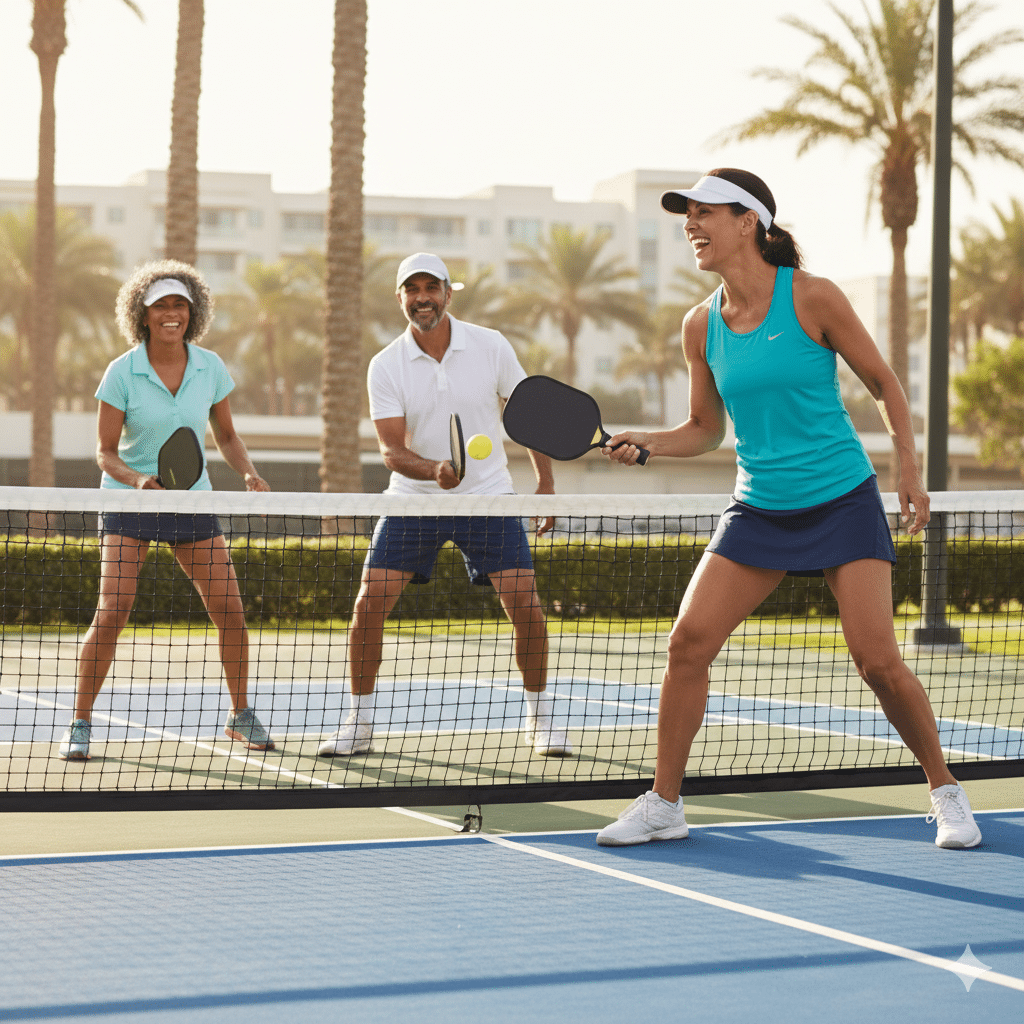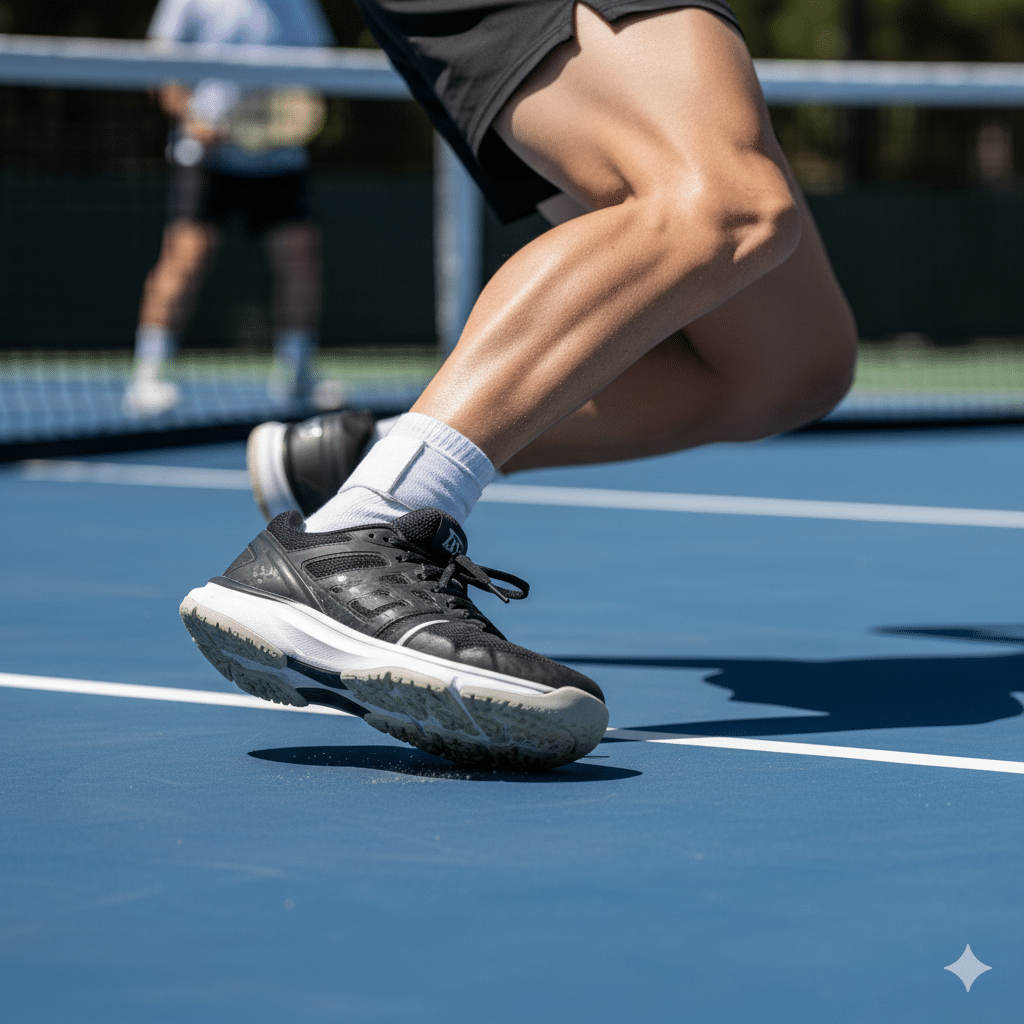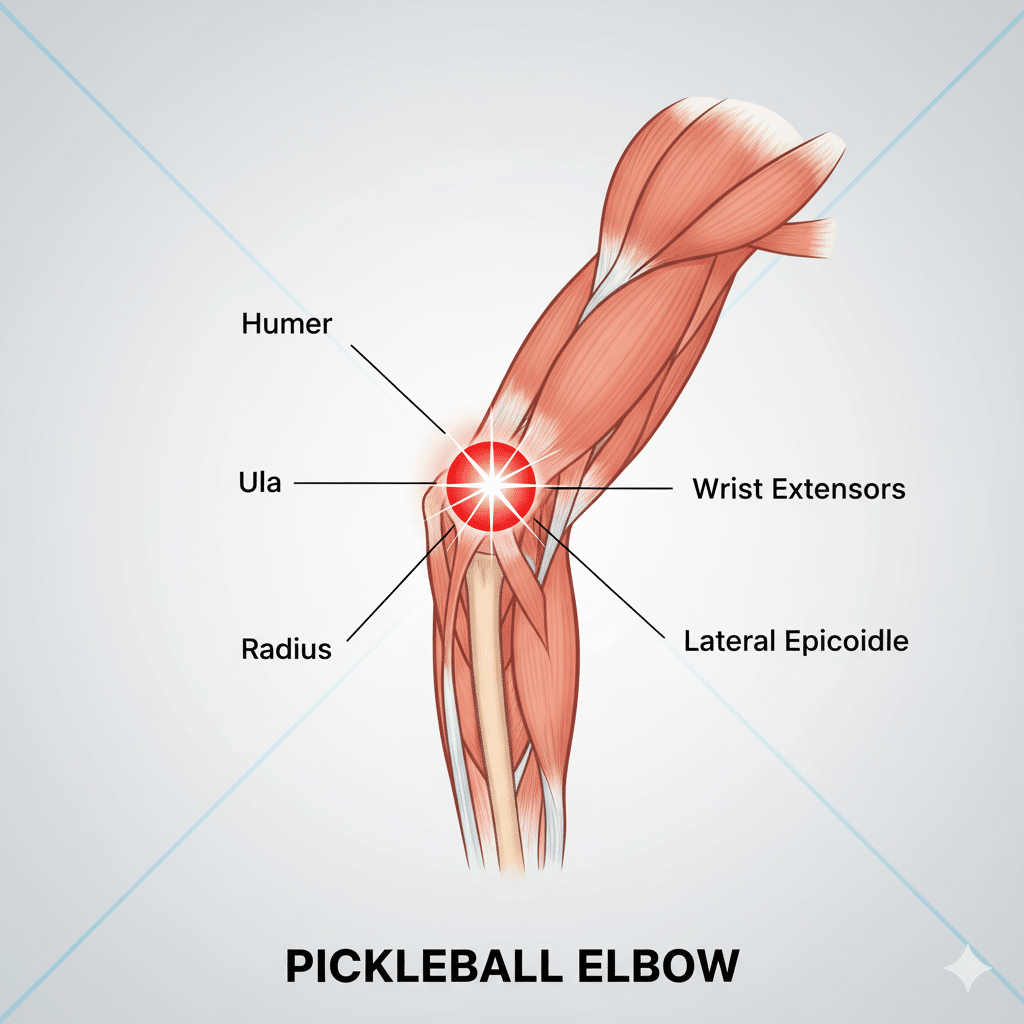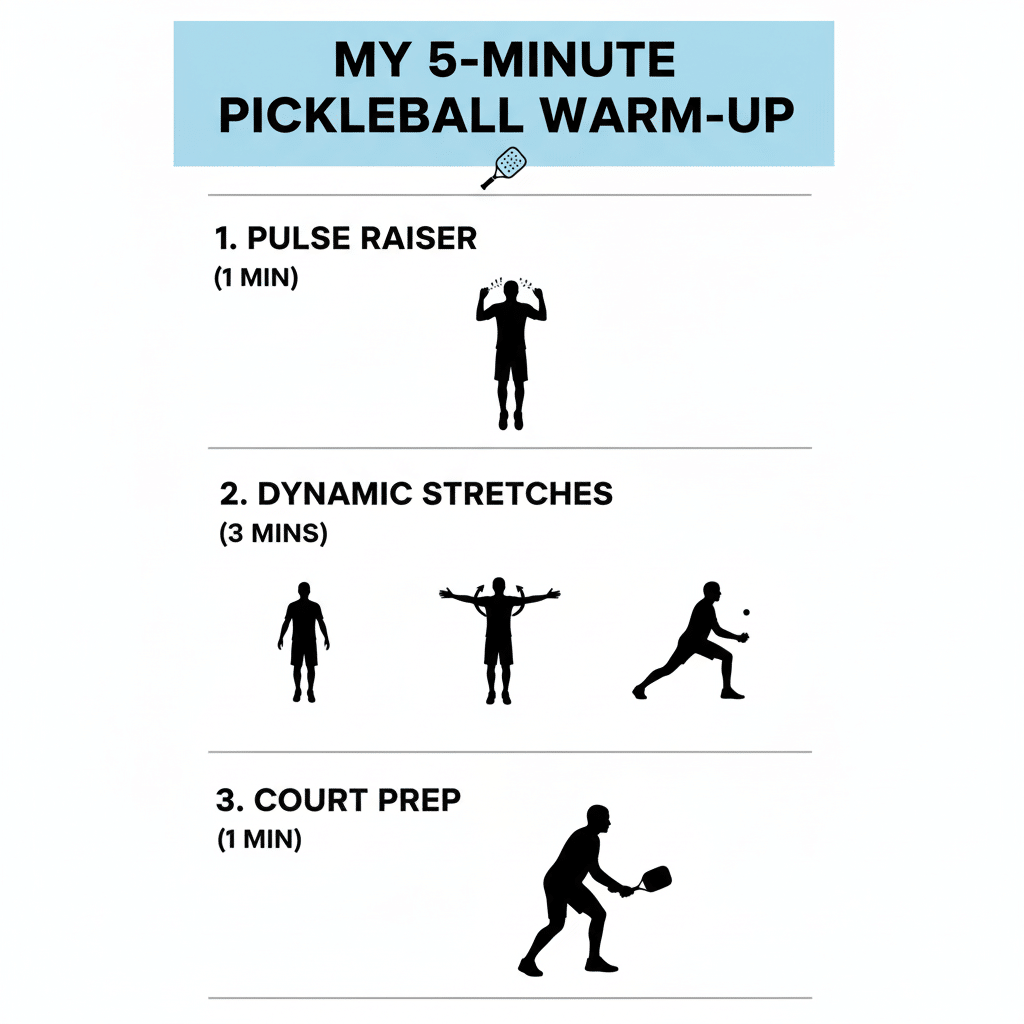It’s official: the world has a fever, and the only prescription is more pickleball.
What started as a backyard game has exploded into the fastest-growing sport on the planet.
It’s social, it’s fun, and it’s a fantastic way to stay active at any age.
But beneath the friendly dinks and social rallies lies a surprisingly demanding athletic endeavor. The game is a whirlwind of sudden stops, sharp lateral lunges, quick pivots, and repetitive overhead swings. And as millions of new players are discovering, this unique combination of movements can lead to a specific set of aches, pains, and injuries if your body isn’t prepared.
The good news? The vast majority of these issues are preventable.
As physiotherapists, we’re seeing a significant rise in pickleball-related injuries. This guide will walk you through the five most common ones we treat, explain exactly why they happen on the court, and most importantly, give you one key exercise to help you build a more resilient body. Let’s keep you on the court and playing the game you love, pain-free.

Injury #1: Ankle Sprains
The ankle is ground zero for the rapid, multi-directional movements that define pickleball. A sprain occurs when the ligaments that support the ankle are stretched beyond their limits, often resulting in swelling, pain, and instability.
Why it happens in pickleball: Every quick lunge to the side for a dink shot, every sudden stop at the “kitchen” line, and every awkward landing after an overhead smash puts your ankle ligaments to the test. If the small stabilizing muscles around your ankle are not strong and responsive enough, a simple misstep or pivot can easily lead to a “rolled” ankle.
Your Key Prevention Exercise: Single-Leg Balance with Head Turns
This exercise trains your proprioception—your body’s ability to sense its position in space—which is crucial for ankle stability.
- Stand on one foot, keeping a slight bend in your standing knee.
- Find your balance. Focus on keeping your foot, knee, and hip in a straight line.
- Once you feel stable, slowly turn your head to look to the left, then return to the center.
- Then, slowly turn your head to look to the right, and return to the center.
- The head turns will challenge your balance system and force your ankle muscles to work harder.
- Aim for 30-45 seconds on each leg. To make it harder, try closing your eyes briefly.

Injury #2: Pickleball Elbow (Lateral Epicondylitis)
You’ve heard of “Tennis Elbow,” and this is its nearly identical twin. It’s an overuse injury that causes pain on the outside of the elbow, resulting from inflammation of the forearm tendons that attach there.
Why it happens in pickleball: This injury stems from repetitive strain on the wrist extensor muscles. Every backhand shot, especially slices, requires these muscles to contract. Compounded over hundreds of swings, and often made worse by gripping the paddle too tightly or using a paddle that’s too heavy, these tendons can become inflamed and painful.
Your Key Prevention Exercise: Wrist Extensor Curls
Strengthening these specific muscles is the best way to make them more resilient to the demands of the game.
- Sit in a chair and rest your forearm on your thigh, with your palm facing down and your hand hanging off your knee.
- Hold a light weight (a 1-2 kg dumbbell or even a can of soup works well).
- Slowly lower your wrist down towards the floor, feeling a gentle stretch.
- Then, slowly curl your wrist upwards as far as you can comfortably go, squeezing the muscles on top of your forearm.
- Perform 2-3 sets of 12-15 repetitions.

Injury #3: Rotator Cuff Strains
Your rotator cuff is a group of four small, deep muscles that stabilize your shoulder joint. They are the unsung heroes of every serve, smash, and high volley.
Why it happens in pickleball: The powerful, repetitive overhead motions can fatigue these stabilizing muscles. When they get tired, they can’t control the movement of the shoulder joint as effectively, leading to irritation, inflammation (tendinitis), or even small tears. This is especially common in players who significantly increase their playing time too quickly or who lack proper warm-ups.
Your Key Prevention Exercise: Banded External Rotation
This exercise directly targets and strengthens the key muscles that decelerate your arm after a swing, protecting the shoulder joint.
- Stand with your elbow bent to 90 degrees and tucked into your side. You can place a small, rolled-up towel between your elbow and your body to ensure it stays in place.
- Hold a light resistance band with both hands, with some tension in the band.
- Keeping your elbow pinned to your side, slowly rotate your forearm outwards, stretching the band.
- Focus on squeezing your shoulder blade. The movement should come from the shoulder, not by twisting your body.
- Slowly return to the starting position.
- Perform 2-3 sets of 15 repetitions on each arm.
Injury #4: Achilles Tendinitis
The Achilles tendon is the thick, powerful cord that connects your calf muscles to your heel bone. It acts like a spring, helping you push off for explosive movements.
Why it happens in pickleball: Pickleball keeps you on your toes—literally. The constant “ready” position on the balls of your feet, combined with thousands of quick push-offs to dart forward and backward, places an enormous cumulative load on the Achilles tendon. Over time, this can lead to micro-damage and inflammation.
Your Key Prevention Exercise: Eccentric Heel Drops
This is the gold-standard exercise for building tendon health and resilience.
- Stand with the balls of your feet on the edge of a step or stair.
- Use a wall or railing for balance.
- Push up with both feet so you are on your tiptoes.
- Lift your uninjured foot off the step.
- Very slowly (count to 3 or 4), lower your injured heel down below the level of the step until you feel a deep stretch in your calf.
- Place your other foot back on the step to help push back up to the starting position. Do not push up with only the affected leg.
- Perform 2-3 sets of 15 repetitions.
Injury #5: Lower Back Pain
Your back is the center of your kinetic chain. It connects your powerful lower body to your swinging upper body, and it takes a lot of rotational stress during a pickleball match.
Why it happens in pickleball: The sustained, low, athletic “ready” stance can fatigue the postural muscles in your back. Furthermore, every time you bend and twist to hit a low dink or reach for a wide shot, you are putting rotational forces through your lumbar spine. If your core muscles (abdominals, obliques, glutes) are not strong enough to stabilize your torso, your lower back can take the brunt of these forces, leading to muscle strains or joint irritation.
Your Key Prevention Exercise: Bird-Dog
This exercise is phenomenal for building a stable core that resists rotation, which is exactly what you need to protect your spine on the court.
- Start on your hands and knees in a tabletop position, with your hands under your shoulders and your knees under your hips.
- Engage your core, keeping your back flat (imagine balancing a glass of water on your lower back).
- Simultaneously extend your right arm straight forward and your left leg straight back.
- Keep your hips and shoulders square to the floor. Don’t let your hip hike up.
- Hold for 2-3 seconds, then slowly return to the start.
- Alternate sides, maintaining control.
- Perform 2-3 sets of 10-12 repetitions per side.
Action Plan: Your 5-Minute Pre-Game Warm-Up
Never walk onto the court cold. A dynamic warm-up increases blood flow to your muscles, lubricates your joints, and primes your nervous system for the quick reactions the game demands.

- Pulse Raiser (1 Minute): Get your heart rate up.
- 30 seconds of light jogging in place or jumping jacks.
- 30 seconds of high knees and butt kicks.
- Dynamic Stretches (3 Minutes): Move your joints through their full range of motion.
- Leg Swings: 10 forward/backward and 10 side-to-side on each leg.
- Torso Twists: 10 to each side, keeping your feet planted.
- Arm Circles: 10 forward and 10 backward with each arm.
- Walking Lunges: 5 on each leg, with a gentle twist over your front knee.
- Court Prep (1 Minute): Get specific.
- Gentle shadow swings (forehand and backhand).
- Practice a few dinks with your partner if possible.
Play Smarter, Not Harder
Pickleball is a sport you can enjoy for decades, but longevity requires preparation. By integrating these simple prevention exercises into your weekly routine and committing to a 5-minute warm-up before you play, you are investing in a future with more time on the court and less time on the sidelines.
An injury doesn’t have to be part of your pickleball story.
Don’t get sidelined by a preventable injury. If you’re feeling a niggle or want to optimize your performance, visit Physiogain for a sports-specific assessment to bulletproof your body for the court.